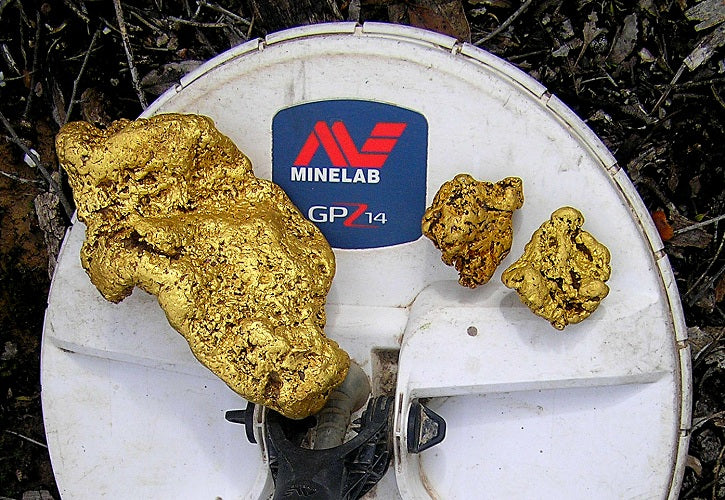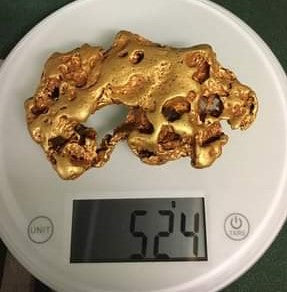Minelab GPZ 7000 - a Deep Gold Getter
Minelab GPZ 7000 - a Deep Gold Getter
The Minelab GPZ 7000 detector was released about 8 years ago in 2015. Costing nearly ten grand, this Minelab detector is suited for serious/deep gold hunting. Experienced users often refer to the GPZ 7000 detector as the "7"or "7,000" or "Zed".
Unique ZVT Technology
The GPZ 7000 is a unique detector as it features Minelab-Patented ‘Zero Voltage Transmission’ (ZVT) technology – which, technically, is different to both Pulse Induction (PI) technology and Very Low Frequency (VLF) technologies. The inventor of the patented Minelab ZVT technology, Dr Bruce Halcro Candy, explained the differences between VLF, and PI, and ZVT technologies as follows:
“Very Low Frequency (VLF) – VLF sinewave detectors have a major disadvantage in having to ground balance out, all of the soil signals simultaneously (all three soil components above).
Pulse Induction (PI) – PI metal detectors have a major advantage of not even detecting the major soil signal; the X component, but only the saline components, but this is mostly insignificant, and the VRM component, which is just a very small percentage of the X component.
This makes the capability of PI technology to ground balance far more accurate than VLF detectors.
A disadvantage of PI is its lesser ability to detect very small nuggets compared to VLF detectors.
Another disadvantage of PI is its capability at detecting very large nuggets compared to CW metal detectors, such as ZVT. CW means Continuous Wave and includes all technologies that do not have zero transmit periods (almost all technologies other than PI).
Zero Voltage Transmission (ZVT) – ZVT has the same major advantage as PI for ground balancing in not detecting the major soil component X, but has the same advantage of CW metal detector technologies compared to PI for detecting very large nuggets because ZVT is CW (unlike PI that is not CW), and also the same advantage as PI for being relatively insensitive to saline soils compared to VLF.”
So, in simple terms - you get the best of both worlds - ZVT technology has the same excellent ground balancing properties of Pulse Induction (PI) technology while retaining Continuous Wave (i.e VLF) technology's ability to detect very small nuggets - so you can find more gold of all sizes, including deeper, even in highly mineralised soils.
Advantages of the GPZ 7000 Super-D coils - compared to Monoloop coils for PI detectors
Conventional configuration Monoloop (“Mono”) coils, and Double D coils, would both not operate effectively with ZVT technology. Hence, Minelab invented the ‘Super-D’ configuration coils (sometimes referred to as a “DOD” configuration coil).
The Minelab Super-D coils consists of two symmetric D shaped receive windings (one on the left and one on the right), with a central, oval-shaped transmit winding. This Super D coils winding geometry provides a double audio response for shallow targets, and a single audio response for deeper targets.
The Minelab Super-D coils have also been designed to have minimal response to the impacts of scraping and knocks to the coil housing - which can cause annoying false signals during detecting e.g. some PI detector coils suffer from this.
The Minelab GPZ14 Super-D coil (which is actually 14’x13’ in size), and the bigger GPZ19 Super-D coil (actually 19’x18’ in size, and weighs 1.83kg), are also both waterproof to a rated depth of 1 metre. The GPZ 7000 detector control box & control panel are NOT rated as waterproof.
Other Features of the GPZ 7000
Unlike the GPX 5000 and GPX 6000 (and most other Minelab detectors), the GPZ 7000 features a concealed coil cable whereby the coil cable (and plug) is housed (internally routed) within the removable lower shaft.
Unlike the GPX 6000, the GPZ 7000 does not have a built-in speaker. However, the GPZ 7000 is supplied with a wireless ‘Audio Module’ speaker (WM12).
With 256 Noise Cancel channels, the GPZ 7000 has enhanced immunity against Electromagnetic Interference (EMI), and hence picks up less atmospheric noise, including from power lines, electrical equipment, and also other metal detectors operating nearby. There are two options to Noise Cancel - either via Auto Noise Cancel function (Default), or manually. Auto is the recommended setting, and may take up to about one minute.
Most people immediately notice the weight difference between the 7000 (3.22kg) and the younger Minelab sibling GPX 6000 (2.1kg) - with the 7000 being about 50% heavier than the 6000.
The use of a quality Bunji/Bungee/Bungy cord can effectively reduce the "swing arm-carried" weight of a detector by at least one-half (50%) e.g. so that the GPZ 7000's "felt weight" is comparable to the full weight of the GPX 6000.
Recommended Techniques for Achieving Optimal Performance
Like other Minelab detectors, good ground balancing techniques are crucial to getting the optimal performance capabilities out of the detector. The initial ground balancing technique for the GPZ 7000 IS DIFFERENT to the technique you should use for a Minelab Pulse Induction (P.I.) detector like the GPX series of detectors. Minelab recommend the following ground balancing technique for the GPZ 7000:
“Ground Balancing VERY IMPORTANT
The best way to ground balance initially after switch on with the Quick Trak trigger depressed, is to sweep the coil in a typical side to side search mode at the expected operating height above the soil surface, e.g. 2–3 cm or whatever the soil saturation or terrain will allow, but at the same time move forward at slightly faster than normal walking speed, so as to cover as much different ground as possible in the first 10 to 12 seconds. The idea during this initial period after turn on, is to expose the detector to as much different soil data as reasonably possible to improve the
initial calibration.
IMPORTANT! DO NOT ground balance using a coil up and down motion (like one would do using a PI detector) initially after turn-on with the Quick Trak trigger depressed. This does not give the initial calibration enough different soil information to calibrate optimally. If ground balance is required again sometime later (but without turning the detector off), ONLY THEN is the usual (PI type of) ground balancing up and down coil motion OK.”
Minelab Software Updates
There have been two software updates released by Minelab for the GPZ 7000.
The first update (released in 2015) related to a new auto ground tracking algorithm, and improved auto ground balance function.
The second update (released in 2017) featured an all-new ‘Ground Smoothing’ function as a primary enhancement. This function provided selectable noise filters that help deal with difficult ground, especially salty soils. A ‘Semi-Auto’ setting was also added to the ‘Ground Balance Mode’ to provide improved ground balance stability.
Yellow Ferrite Ring Ground Balancing
Minelab also recommended the use of their Yellow Ferrite Ring for optimal ground balancing.
Minelab stated:
“It’s very important to Ground Balance the GPZ 7000 using the yellow ferrite at the start of your detecting session. By doing this, any ferrite-like components encountered in the soil will not cause any false signal audio responses. The updated software shows the use of the yellow ferrite as part of the animated guide sequence when you follow the Quick Start/Quick-Trak process. (This is also a way to determine if a GPZ 7000 detector has the new software installed.)”
Accessories included with the Minelab GPZ 7000 detector
Accessories included in the Minelab GPZ 7000 box (in addition to the detector + Minelab GPZ14 coil) are:
Quick-Detachable Control (Guide) Arm + WM12 Wireless Audio Module + KOSS headphones + Pro-Swing 45 Harness + battery charger & charging cables.
Optional Coils
The Australian company ‘Nugget Finder’ (NF) recently released the Minelab-approved ‘Z-Search’ range of non-spoked coils, namely a 17x13" elliptical coil, and also a 12" round coil. These coils have a DOD configuration, a 3year Warranty, and are rated as water resistant to 1metre. These NF coils also include a Minelab lower shaft.

Several incredible gold nuggets have been discovered in Australia over the past 8 years using the GPZ 7000, including down to depths of about 1 metre, and no doubt yet more big nuggets will continue to be unearthed.













